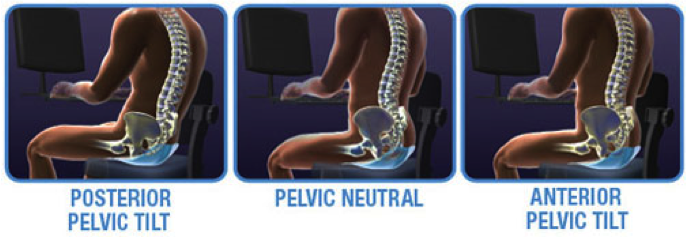How to sit correctly & how to choose a suitable office chair
Lower back pain associated with prolonged sitting is one of the most common complaints made by patients. Prolonged sitting in a slouched posture, results in increased pressure through the discs, joints and muscles in the lower back, resulting in pain. Adhering to correct sitting posture, plays a vital role in relieving pain and preventing long-term damage to your spine. Correct posture aligns the spine in its normal anatomical position (neutral position), therefore reducing strain through the spine and attaching muscles. Correct sitting posture is also important to reduce neck pain and headaches. With the “computer age” well and truly upon us, the common tendency is for us to sit in front of a computer in a “poked chin” posture. This places considerable strain through the joints and muscles in the neck and is a common source of headaches.
The following table highlights the main aspects of correct sitting posture.
| Postural Position | Recommendations |
| Head/Neck Posture | A “chin tuck” posture should be utilized to minimize strain through the lower neck junction. This posture aligns the spine correctly, reducing pressure through the cervical discs and neck musculature, therefore reducing the onset of neck/shoulder pain and headaches. |
| Shoulder Posture | The shoulders should be drawn “down and in” to prevent “rounding” of the shoulders, which can lead to the onset of mid-back/shoulder pain. This will assist in maintaining correct spinal alignment through the thoracic spine (mid-back) and plays a role in reducing the risk of developing shoulder impingement symptoms. |
| Lower back | The lower back should be maintained in its “neutral position”, displaying a slight inward curve. This curve should align with the lumbar support on the chair, resulting in decreased pressure through the lumbar discs. |

The type of chair you sit in is also an important factor. An ergonomically correct chair can play a vital role in reducing back pain, as well as facilitating correct posture. It should be remembered though, that sitting in even the most expensive ergonomic chair, does not mean your posture will be correct!!! It is still important for you use your muscles to achieve correct posture and use the chair to facilitate that posture.
When choosing an office chair the following criteria should be considered.
| Seat Characteristics | Recommendations |
| Chair Height | Correct seat height enables the elbows to rest at 90 degrees on the desktop, with the hands being at the same level of the home row of keys (ASDF). Correct height also ensures that the knees are slightly lower than the hips, therefore maintaining a neutral lumbar spine posture (lordosis). This posture minimises strain through the pain sensitive structures of the spine, including the discs and facet joints. |
| Seatpan Design | Seat pan should be slightly concaved with a “waterfall” front. This maintains a correct lower spine posture and reduces pressure on the back of the thigh/knee, enabling blood to circulate freely to the legs and feet. |
| Seat Depth | Should be able to fit 2 fingers between the front of the seat and the back of the knees, to further enhance circulation. |
| Lumbar Support | Should be adjustable (up/down and forward/backward) to accommodate variations in postures. Support should be positioned in the inward curve (small) of the lower back. Additional support may be required via an external lumbar support. |
| Backrest | Backrest should support the entire back including the lower spine. Backrest angle should be approximately 100 degrees from the horizontal. |
| Armrests | Armrests prevent the operator from sitting close to the desk and are therefore not recommended for workstations where word processing is predominately performed. When present, armrests should be adjustable so that they can fit under the desk to allow users to get close enough to the work surface. |
| Footrests | Footrests are useful to ensure that the hips remain higher than the knees, when the desk and/or chair height are incompatible to the individuals characteristics. A footrest should be angled at 10 to 20 degrees. |

